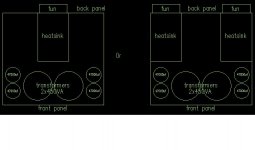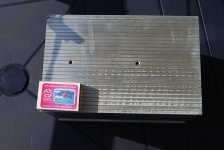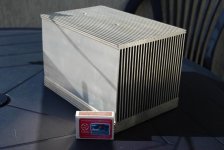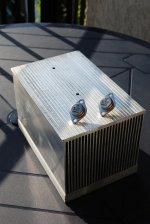Adi2009 said:put this heatsink horizontal in chassis?
Horizontal is the common way for PA amplifiers.
The FM acoustics 811 has been manufactured with a horizontal heatsink/fan arrangement for some 20 years, still used in many recording studios, a Reference 811 power amp buys half a Ferrari 430.
A blowing fan is more efficient than a sucking fan, it runs cooler and likely to have a longer life, but then your amplifier will quickly/slowly cook.
Agree on first two since fan is blowing cool air through itself (Forced Convection arrangement) instead of sucking hot air through itself (Induced Convection arrangement).
But why would amp "quickly/slowly cook" any more if blowing cool air as opposed to sucking hot air? Won't the amp generate same heat either way?
I have always wondered how small the heatsinks could be if I could use a fan cooled arrangement with a water vaporizer into the fan inlet. You get some monster cooling potential with the vaporization of atomized water on the sinks. As long as your not in a humid environment, that is.
look at his physical layout.john65b said:But why would amp "quickly/slowly cook" any more if blowing cool air as opposed to sucking hot air? Won't the amp generate same heat either way?.
A sucking fan will suck the hot air through the sinks and expel it out the back.
The internal components will in a random flow of relatively cool air entering through the various holes/vents/leaks in the chassis.
Now substitute a blowing fan and where does the hot air from the heatsinks flow to?
Directly at the components that should be kept cool.
"Slowly cook" is an appropriate to my understanding of the thermodynamics involved .
Have you any knowledge of the heath risks from Legionnaires' disease?john65b said:use a fan cooled arrangement with a water vaporizer into the fan inlet. You get some monster cooling potential with the vaporization of atomized water on the sinks.
Do not ever use warm water in an atomised form where there are humans around.
I agree...
I just moved from Utah where "Swamp coolers" or evaporative coolers are commonplace.
swamp cooler
Basically same concept. I do not remember exactly what the main driver in Legionaires disease was , but from what I remember, it was a bacteria laden stagnant condensation from air conditioning cooling system (air conditioning is a dehumidification process) . When aspirated caused all sorts of pneumonia like ailments.
In the 7 years I spent in Utah around evaporative coolers, never heard of an outbreak.
If you ever visit Las Vegas at any of the casino pools, they have tubes of water with mist nozzles blowing water vapor on pool decks, Even walking through the strip, water mist is sprayed everywhere to cool from the 110 F temp.
Maybe its treated or fresh tap water they use to mitigate probability of Legionaires?
I just moved from Utah where "Swamp coolers" or evaporative coolers are commonplace.
swamp cooler
Basically same concept. I do not remember exactly what the main driver in Legionaires disease was , but from what I remember, it was a bacteria laden stagnant condensation from air conditioning cooling system (air conditioning is a dehumidification process) . When aspirated caused all sorts of pneumonia like ailments.
In the 7 years I spent in Utah around evaporative coolers, never heard of an outbreak.
If you ever visit Las Vegas at any of the casino pools, they have tubes of water with mist nozzles blowing water vapor on pool decks, Even walking through the strip, water mist is sprayed everywhere to cool from the 110 F temp.
Maybe its treated or fresh tap water they use to mitigate probability of Legionaires?
A sucking fan will suck the hot air through the sinks and expel it out the back. The internal components will in a random flow of relatively cool air entering through the various holes/vents/leaks in the chassis. Now substitute a blowing fan and where does the hot air from the heatsinks flow to? Directly at the components that should be kept cool. "Slowly cook" is an appropriate to my understanding of the thermodynamics involved .
Sorry,
I thought we were talking of a tunnel type heat sink, where the air was just going through the inside of a heatsink, and not throughout the chassis.
I remember a similar cooling issue on computers...forced cool air into Chassis (Internally positive pressure forcing air out of chassis) and forcing hot air out of chassis (internally negative pressure sucking air in chassis)... don't remember which one was identified as cooler.
I am in the camp that likes positive internal pressure, as it keeps more dust out of your chassis. Maybe matters more if you keep your computer on all the time or shut it down when not in use.
we are referring to a fan cooled "tunnel" heatsink.john65b said:I thought we were talking of a tunnel type heat sink, where the air was just going through the inside of a heatsink, and not throughout the chassis.
If the fan is a blower and the fan is at the back of the chassis then the outlet from the tunnel would normally be at the front of the tunnel.
Just where the caps and amplifier are located.
Adi2009 said:very big H=25cm
The heatsink has a length of 21cm, a 120mm diameter fan does 3.8cm.
You'll also need something to mount the fan to the heatsink, that simultaneously closes the remaining 1.5cm in two directions for efficiency sake.
The adaptor would have to have some thickness to enable plenty of cold air to flow along every rib of the heatsink, think about half an inch between fan and heatsink.
Ad to that the thickness of top and bottom chassis plate, plus a couple of centimeters between the floor and underside of the amplifier, and your amp will be 12"/30cm high.
The rest of the amplifier chassis will be a lot of futile space, not very rational to put a heatsink with such length in a vertical position.

- Home
- Amplifiers
- Solid State
- Krell KSA 50 PCB



